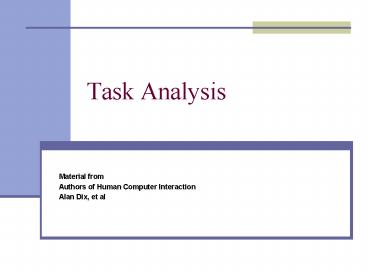Task Analysis - PowerPoint PPT Presentation
1 / 16
Title:
Task Analysis
Description:
Taxonomies represent levels of abstraction. Example: motor controls ... Detailed interface design. taxonomies suggest menu layout ... – PowerPoint PPT presentation
Number of Views:285
Avg rating:3.0/5.0
Title: Task Analysis
1
Task Analysis
- Material from
- Authors of Human Computer Interaction
- Alan Dix, et al
2
Overview
- What is task analysis?
- Task Analysis Methods
- task decomposition
- knowledge based analysis
- entity-relationship techniques
- Sources of Information
- Uses of Task Analysis
3
What is Task Analysis?
- Process of analyzing people's jobs
- what people do
- what things they work with
- what they must know
- Not limited to parts of computer system
4
Approaches to task analysis
- Task decomposition - splitting task into
(ordered) subtasks - Knowledge based techniques - what the user knows
about the task and how knowledge is organized - Entity-relation based analysis - relationships
between objects and actions in the task
5
Differences from other techniques
- Systems analysis
- focus - system design
- Cognitive models
- focus - internal mental state as user performs
task - granularity small unit' task
- Task analysis
- focus user and external observable actions
- granularity - whole job
6
Task Decomposition
- Aims
- describe the actions people do
- structure them within task subtask hierarchy
- describe order of subtasks
- Focus on Hierarchical Task Analysis (HTA)
- It uses
- text and diagrams to show hierarchy
- plans to describe order
7
Textual HTA description
- Hierarchy description ...
- 0. in order to clean the house
- 1. get the vacuum cleaner out
- 2. fix the appropriate attachment
- 3. clean the rooms
- 3.1. clean the hall
- 3.2. clean the living rooms
- 3.3. clean the bedrooms
- 4. empty the dust bag
- 5. put vacuum cleaner and attachments away
- ... and plans
- Plan 0 do 1 - 2 - 3 - 5 in that order. When the
dust bag gets full do 4 - Plan 3 do any of 3.1, 3.2 or 3.3 in any order
depending on which - rooms need cleaning
- N.B. only the plans denote order
8
Diagrammatic HTA
Check/improve it!
9
Knowledge Based Analysis
- Focus on
- Objects - used in task
- Actions performed
- Taxonomies represent levels of abstraction
- Example
- motor controls
- steering steering wheel, indicators
- engine/speed
- direct ignition, accelerator, foot brake
- gearing clutch, gear stick
- lights
- external headlights, hazard lights
- internal courtesy light
10
Taxonomy - Task Description Hierarchy (TDH)
- Three types of branch point in taxonomy
- XOR - object in one and only one branch
- AND - object must be in both
- represents multiple classifications
- OR - can be in one, many or none
- Example
- wash/wipe AND
- function XOR
- wipe front wipers, rear wipers
- wash front washers, rear washers
- position XOR
- wipe front wipers, rear wipers
- wash front washers, rear washers
11
More on TDH
- Knowledge-representation grammar each object
can be represented by a unique path in the
hierarchy (pg 522) - Example plate can be referred to as
- kitchen item / shape(flat) / functionpreparation,
dining(for food)/ - nothing else fits this description
12
Entity-Relationship Based Techniques
- Emphasis on objects, actions and their
relationships - Similar to DB design and object-oriented
analysis, but - includes non-computer entities
- emphasis is domain understanding not
implementation
13
Sources of Information Early analysis
- Documentation
- manuals, training materials
- say how supposed to do task, not how actually
done - Observation
- watch people as they perform task
- passively or actively / in lab or at site
- post task walkthrough
- Interviews
- use documentation to ask questions
- domain experts / managers / workers
14
Sources of Information Detailed analysis
- list nouns (objects) and verbs (actions)
- beware technical language and context
- the rain poured
- I poured the tea'
- Sorting and classifying
- grouping or arranging words on cards
- ranking objects/actions for task
- relevance (see Ch. 11)
- use commercial outliner
15
Sources of Information Analysis
- Iterative process
- data sources ? analysis
- But costly, so use cheap sources where available
16
Uses of Task Analysis
- Manuals, Training Materials and Documentation
- HTA used to structure manual
- Knowledge-based techniques best for structuring
course - Requirements elicitation and systems design
- lifts focus from system to use
- suggests candidates for automation
- uncovers user's conceptual model
- Detailed interface design
- taxonomies suggest menu layout
- object/action lists suggest interface objects
- task frequency guides default choices
- existing task sequences guide dialogue design































